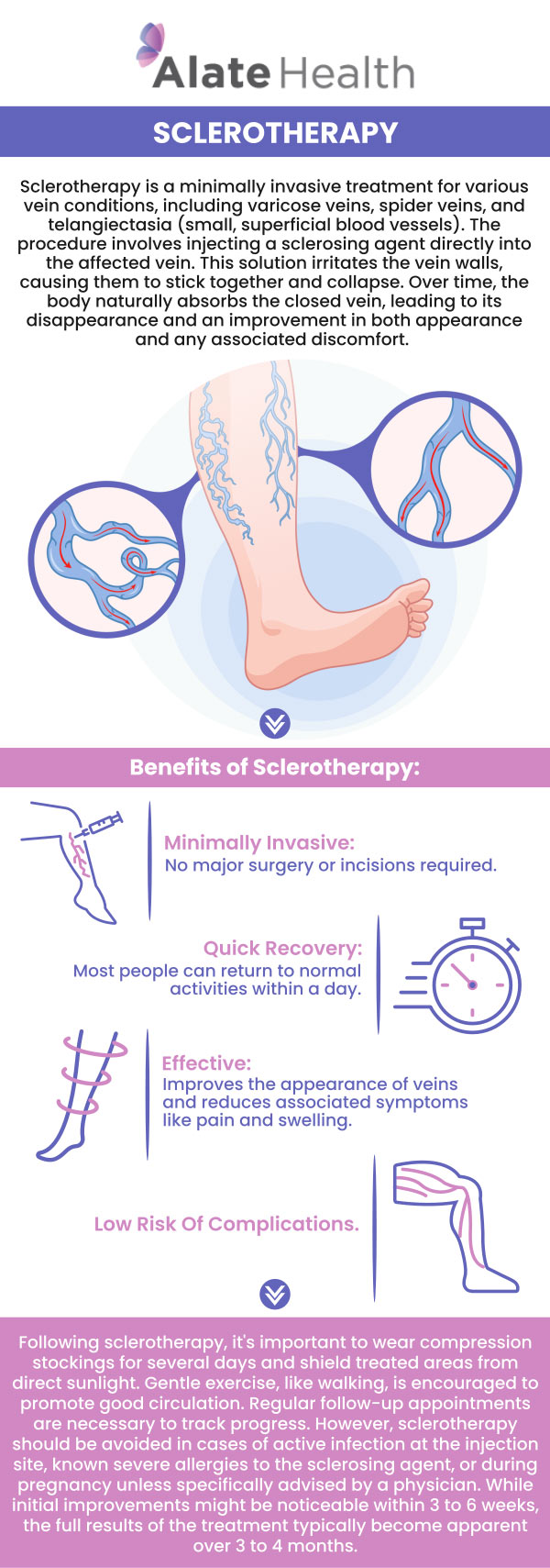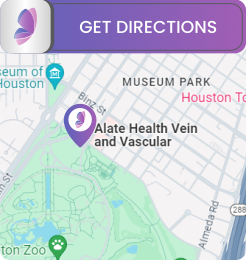Is Sclerotherapy Right for You?
Sclerotherapy is a minimally invasive procedure that involves injecting a solution into varicose veins to cause them to shrink and fade. It’s a popular choice for those seeking a less invasive alternative to surgery. Consult with Andrew Doe, MD at Alate Health Interventional Radiology Clinic to determine if sclerotherapy is the right fit for your specific needs. Factors such as the severity of your varicose veins, your overall health, and your personal preferences will influence the decision. For more details, contact us today or book an appointment online. We are conveniently located at 1213 Hermann Dr Suite 255, Houston, TX 77004.




Table of Contents:
What does sclerotherapy do to veins?
How do you know if sclerotherapy is working?
Is sclerotherapy vein treatment right for you?
How painful is sclerotherapy?
At Alate Health Interventional Radiology Clinic, we are well-versed in the intricacies of sclerotherapy, a minimally invasive procedure extensively utilized for the treatment of varicose and spider veins. Our team of skilled professionals is proficient in administering the sclerosant solution, typically a salt solution, directly into the troublesome vein. This effectively causes the blood vessels to scar, clot, and eventually collapse.
Our primary goal with sclerotherapy is to damage and seal off the problematic veins, which is achieved by the sclerosant solution causing the vein walls to adhere together, thereby disrupting the blood flow. Over time, the body naturally absorbs the scarred and sealed vein, causing it to fade from sight. The blood that would usually flow through the treated vein is rerouted through healthier veins, which improves overall blood circulation in the affected area.
We understand that while sclerotherapy is highly effective in reducing the appearance and discomfort of varicose and spider veins, it doesn’t stop new ones from developing. Therefore, our team is committed to providing comprehensive patient care, including multiple or ongoing treatments when necessary.
Sclerotherapy is typically performed in our clinic without the need for anesthesia. Because of its great efficacy and low-risk factors, it has gained popularity as a therapy choice. But, just like with any medical operation, there is a chance of negative effects that could include bruising, swelling, changes in skin color, and, in rare cases, more severe complications such as blood clots or inflammation. Therefore, our healthcare professionals emphasize a thorough consultation process to ensure our patients understand the benefits and risks associated with sclerotherapy.
We specialize in providing sclerotherapy treatments, an effective method for eliminating varicose veins and spider veins. It’s crucial to understand the indicators of a successful sclerotherapy treatment, which include:
• Disappearance or Fading of Veins: After sclerotherapy, the treated veins should reduce in appearance or disappear completely. This can be immediate or occur over a period of weeks or months. This visible change indicates the successful outcome of the procedure.
• Alleviation of Symptoms: If you experience a reduction or complete elimination of pain, itching, swelling, night cramps, and discomfort associated with varicose or spider veins post-treatment, it indicates that the procedure has been successful.
• Improved Skin Appearance and Texture: The success of sclerotherapy is also characterized by smoother, less discolored skin around the treated area. The appearance of lumpy or bulging veins should also improve as the veins become less noticeable.
We ensure regular follow-up appointments to monitor your recovery process. Using ultrasound technology, we examine the treated veins and assess the results of the therapy, determining if additional treatments are necessary.
• Initial Response: The first signs of successful sclerotherapy treatment should be observed within a few weeks as the veins begin to fade or disappear.
• Long-Term Results: It may take several months to fully appreciate the results as the veins continue to fade.
• Variability in Response: Each patient’s response to sclerotherapy can vary based on factors like vein size and underlying health conditions, among others.
We prioritize patient care and take any complications seriously. If you experience any significant pain, swelling, or discoloration that persists or worsens after sclerotherapy, we urge you to contact our healthcare professionals promptly.
Our clinic specializes in treating small to medium-sized varicose veins or spider veins through sclerotherapy. However, we are aware that every patient is different, and larger veins may require alternative treatments, such as vein stripping or endovenous laser treatment. Our team of qualified vein specialists will conduct a thorough assessment of your veins to determine the most suitable treatment option for you.
We focus on patient comfort and safety. Sclerotherapy doesn’t require incisions or anesthesia, and within a few days, the majority of patients are able to return to their regular activities. There is a possibility of adverse effects, such as mild discomfort, reactions to the solution used, or bruising. Our team is well-equipped and experienced in managing these risks.
Before your procedure, we will provide comprehensive instructions on medication adjustments, including blood thinners, and guide you on what to expect during recovery. We discourage sclerotherapy in individuals who are pregnant, breastfeeding, or have certain underlying medical conditions, such as active infections or bleeding disorders.
We believe that sclerotherapy can be an effective and aesthetically pleasing solution for addressing spider veins and varicose veins of small to medium size. We encourage you to have an in-depth discussion with our healthcare providers to determine if sclerotherapy is the right option for you. With proper preparation and care, we can help you safely improve the appearance of your veins.
During sclerotherapy, our experienced radiologists inject a sclerosing solution directly into the affected veins. At the injection site, some individuals may feel a mild burning or stinging sensation, though this discomfort is typically brief and manageable. The level of discomfort can be influenced by various factors, such as the concentration of the sclerosing solution, the size of the needle used, and individual pain sensitivity.
We take several measures to minimize any potential discomfort during the procedure. These include the use of a topical numbing cream and local anesthetics to numb the injection site, applying ice packs post-procedure to alleviate any discomfort, and recommending the use of compression stockings to provide support and reduce swelling.
Patients may have moderate bruising, swelling, or discomfort in the treated area following the operation. Usually minor in nature, these symptoms go away in a few days to a few weeks. Over-the-counter pain relievers are generally adequate for managing any post-procedure discomfort.
Though complications such as blood clots or inflammation are rare, they can cause more significant pain. Rest assured, our dedicated team closely monitors each patient to ensure their safety and will promptly address any concerns that arise.
At Alate Health Interventional Radiology Clinic, we are committed to delivering exceptional patient care. If you experience severe or persistent pain following sclerotherapy, we encourage you to consult with our team for further evaluation. For more details, contact us today or book an appointment online. We are conveniently located at 1213 Hermann Dr Suite 255, Houston, TX 77004. We serve patients from Houston TX, Bellaire TX, Jacinto City TX, Spring Valley Village TX, Stafford TX, Bunker Hill Village TX, and surrounding cities.

Additional Services You May Need
▸ Adenomyosis
▸ Enlarged Prostate
▸ Leg Ulcers
▸ Joint Pain
▸ Varicose Veins
▸ Uterine Fibroids
▸ Pelvic Congestion
▸ Vascular Malformations
▸ Dialysis/Renal Failure
▸ Port and PICC Placements
▸ Peripheral Arterial Disease
▸ Primary and Metastatic Liver Cancers
▸ Hemorrhoid Artery Embolization (HAE)







